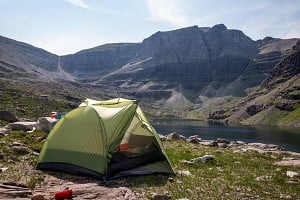
It's a well-established model, but global supply issues meant there was a long wait before I got my hands on this four-season one-person tent for review, so I was delighted when the Access 1 arrived in September, in time for autumn and the winter season ahead. MSR designed the Access tent for ski tours, snowshoeing and camping 'for protected winter conditions found near tree-line' (or likewise semi-sheltered pitches). We think its balance of low-ish weight and high-ish sturdiness also makes it well suited to year-round hillwalking and backpacking.
My use for the Access 1 has primarily been summit camping where I've unintentionally subjected the tent to bad pitching and, at times, less than ideal conditions. While it's not a full-on mountaineering tent, it's the next best thing, and ought to be sturdy enough for most year-round occasions. In windy weather the secret to its solid feel is the addition of a full cross-pole, which creates a stable geodesic structure; and with steep sides that shed snow well, it's built for a fair bit of winter.
See UKH/UKC reviews of the larger version, the Access 2, here and here:
What's Good
- Lightweight
- Freestanding geodesic design
- Winter-worthy weather performance
- Easy setup
- Generous headroom
- Reflective patches
- Decent size porch
What's Not So Good
- Not a budget buy
- Pitches inner first
- Doesn't come with enough stakes
- Doesn't come with a footprint
- It'd be braw if it came with reflective guylines
- Jury is out on the poles. Ask me in another year

Pitching and poles
Experience comes from making mistakes so, drawing from my extensive back catalogue, I wisely set the Access 1 up in my living room first before taking it on the hills. Coming in a bright orange storage bag, the tent itself is available in either orange or green. Mine is the latter - less good for cheerful photos and being seen for safety, but better for keeping a low profile. I did once actually manage to lose a tent on the hill in pitch dark, so was pleased to note reflective patches on the fly here.
Unfortunately one of the snazzy poles emerged already-split from its packet. MSR arranged to send out a replacement section (bit of fiddly shockcord re-threading required). It wouldn't arrive before the tent's inaugural trip to Arran, but I thought the broken pole would more than likely hold up. From long experience I always carry insulating tape to effect emergency repairs, and anyway the forecast wasn't too bad (eyeball roll...).
The tent is free standing which is fab for camping in places where you struggle to get pegs securely into the ground. This also means you can pick the whole thing up and move it to a better spot. Free standing tents can also be more wind resistant because the whole of the tent is supported by the frame.
The Access 1 pitches inner-first, so hope you don't have to erect it during a downpour of biblical proportion. The good news is it does go up pretty quickly. First peg out the inner. The poles come as a symmetrical piece with one long and one shorter section; I found it easier to assemble the longer bit first. These attach to the inner via the aluminium eyelets found at each corner and then in eyelets located centrally. The inner is then raised by clipping it to the poles.
The poles are made by Californian manufacturer Easton Technical Products, a specialist in composite materials and best known for manufacturing arrows for archery. The Syclone poles that come with the Access are engineered from composite materials. Here's the official line on them:
'Built of lightweight, aerospace-grade composite materials, Easton Syclone Poles are the most resilient backpacking tent poles ever made – and the future of tent pole technology. Unlike aluminium and carbon fibre that bends or snaps under heavy winds, Syclone poles flex under force and bounce back to shape, maintaining the reliability of your shelter.'
I can attest that after a night of unexpectedly strong, whirling winds on top of Dun da Ghaoithe (Mull's appropriately-named Fort of the Two Winds), the Access 1 stood up well. Tests conducted by Easton say the poles can withstand wind speeds of 85mph, but that's very different to suggesting a tent will survive the same, and it's not what MSR are claiming. While I do wonder how you'd fare on consecutive nights of such a battering I've zero intentions of putting that to the test.
When you throw the fly over do make sure you have the door opening on the correct side (zoiks). The fly is secured at the corners of the inner and can then be tensioned.
Pegs
You generally get aluminium alloy for best strength vs weight vs cost, but top range tents sometimes have titanium alloy ones. Shape is important; those with a y-beam cross section are less likely to bend than traditional round pegs. BUT DON'T PUSH THEM IN WITH YOUR BOOT! Find a stone to bash them in to reduce the chance of bending the peg because buying quality replacements will require a remortgage.
Only eight came supplied with the Access 1 (an MSR representative told me the measly supply is due to a worldwide shortage of aluminium). Wasn't so good for me when I hadn't supplemented my stash and proceeded to snap one of the few precious stakes in half while stamping it into frozen ground. Extra pegs would have also enabled me to utilise the upper guys, adding stability to the tent in those high winds on Mull and making for a marginally less disconcerting experience.

Space inside
In extremis two thin people do fit inside this tent, but if you weren't close before you're definitely going to be after a night together in this. The Access 1 is a one-person model; for a modest increase in weight, the Access 2 is your two person alternative.
The door opens from either the top or the bottom, and the porch is a reasonable size – sufficiently big enough to use my Jetboil when it has been chucking down outside. (Admittedly this caused a lot of moisture build up on the inside of the fly, but I cared not. Conversely I very much cared to ensure the Jetboil didn't tip forward spilling freshly boiled water into the tent – yes this did once happen and took the skin clean off my feet).
Although the inner is narrow there's ample headroom, thanks both to the max height of over 1m and the addition of a cross-pole that broadens the high portion of the tent, and this makes it feels spacious for a one-person model. At 5'6" I'm able to sit up fully inside the Access 1.
Its floor area of 1.76m2 is pretty decent for a solo shelter. I've found there's room to store backpack and boots inside too, if you don't want to leave them in the porch. And at either end of the tent are mesh pockets for stashing stuff. On the ceiling of the inner are three loops which can be used to thread a line from which you can hang things; I just use the central loop to hang my lantern.
Fabric and Weather Performance
Tech stuff: The flysheet is 20 denier ripstop nylon coated with an 'Xtreme Shield' polyurethane and silicone treatment giving it a 1200mm hydrostatic head. The groundsheet is a slightly tougher 30 denier ripstop with Xtreme Sheild polyurethane and DWR, with a 3000mm hydrostatic head rating. The canopy (inner) is a mix of 20 denier ripstop nylon and 10 denier polyester micromesh - light but tough. A groundsheet is usually a higher denier, since the thicker and heavier the yarn the more robust and durable the material. In tents there's always going to be a trade-off between having a strong and protective material under the user and not making the tent too heavy to carry. MSR have struck a good balance here; while being light enough to backpack or ski with, the Access 1 is also up to plenty of wintry use.
Hydrostatic head, for those that don't know, is how much water pressure the fabric can take in a lab test before it leaks. Technically any value over 1000mm is 'waterproof' but you might reasonably assume that a decent tent wants to be more than that to withstand a proper downpour plus the pressure of being packed away wet and then reused. On paper the hydrostatic head of the Access 1 seems under-powered, but in practise when I've subjected it to downpours or persistent rain the tent hasn't given me any problems. We have noted the comparatively low HH with MSR tents in previous reviews, and also the fact that it never seems to matter in real world use.
On many camps the groundsheet has felt cold and seemed damp, but that's what I've come to expect when pitched on snow or wet, spongy ground, whatever make of tent I'm using. The Access 1 doesn't come with a footprint, but I use one of those lightweight green tarps you find on Amazon for a fiver. It provides the groundsheet with protection from abrasive surfaces and is an adequate additional barrier against damp.
MSR's advice is not to store the tent while it's wet, or even just damp, as this will help avoid premature breakdown of the fabric and coatings. Developed by MSR, Xtreme Shield is a coating that they say is three times more durable than standard treatments, helping to extend the life of your tent.
Nerdy fact: It's worth noting that MSR ditched using seam tape on their tents (it always peels off eventually) and instead on their more all-season tents use a lap-felled seam. This is a seam made by placing one edge inside a folded edge of fabric, then stitching the fold down. The fold encasing the raw edges protects them from fraying, and the whole thing is extremely strong. Meticulous factory stitching creates tiny, precise holes, and uses thread that's a poly-cotton blend which swells when wet. They say that as an extreme measure of defence they add a seam sealing step at the factory. Stitched and sealed seam construction on my tent is so far watertight, but I received a tube of seam sealant if it becomes the case I need to apply it to any areas affected by wear, to prolong the weather protection and life of the tent – nice one.
Condensation and ventilation
Since it's made with snow in mind there's not a huge amount of mesh in the tent's inner (just a small triangle on the door) so more warmth is retained, but I've found there's still enough airflow under the fly to prevent too much in the way of condensation. I've had frost build up inside in both my Terra Nova Quasar and Nordisk Telemark but as yet haven't experienced this problem in the Access 1 – which I've had out in much colder temperatures. Some degree of condensation is inevitable in our climate, but this design seems better at handling it than many. If you're heading somewhere sunny in summer then bear in mind that with limited ventilation it could get stuffy in hot weather. I've a feeling that's not often going to be an issue on my Scottish summit jaunts.
Carrying
The storage bag is a generous size, which makes packing up that bit less faffy, and has a large flap that I use to wrap around the fly when it's soaked to help keep the worst of its wetness away from the inner. I did manage to shred the ends of the bag when I was scrambling on Arran, so it's probably a good idea to carry the tent inside your backpack rather than attach it on the horizontal to the outside. Alternatively, you can shove the poles down one side of your backpack then squish the tent, in its storage bag, down to a much smaller size for carting in your pack.
Weight
MSR say the Access 1 weighs 1.6kg, and it does, but the el cheapo footprint I carry gives me a total weight of 1.7kg – not unreasonable for what I think is a decent winter worthy tent. Slightly disingenuously, manufacturers will often quote a 'minimum' weight for poles, fly and inner only; in this case it's 1.37kg.
When I think about it now I can't believe I used to lug my Terra Nova Quasar 2 on long hikes in to summit camps – all 4.7kg of it. Mental.
Price
Budget is often a main driver when it comes to choosing a tent, but quality doesn't come cheap. The MSR Access 1 retails for a cool £700, though it's available for a fair bit less if you hunt online. That is expensive, but based on my experience of using the tent on summit camps I think it's worth the money.
Summary
The Access line was made to meet the needs of North American backcountry skiers; but what's good for them is similarly handy for 4-season hillwalkers, backpackers, and summit campers. Its freestanding, wind-resisting, snow-shedding geodesic shape makes it well suited to all but the most extreme winter conditions. Spacious enough to comfortably house you and your kit, with generous head room and a good sized porch, the Access 1 is still reasonably light for one person to carry. If you're like me and want it for weekend backpacking trips a few times per month, year round, you don't mind having to pitch the inner first, and are willing to source extra stakes and a footprint, then it's worth giving this tent some serious consideration.












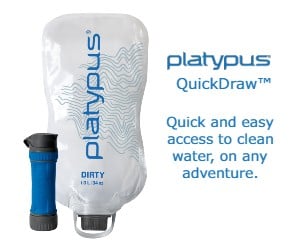
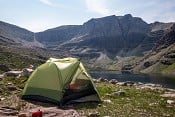
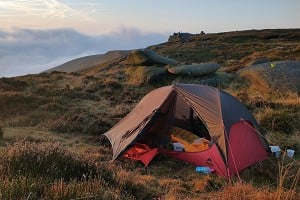
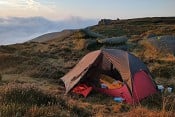
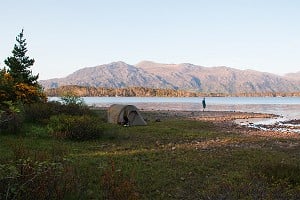
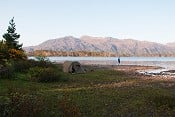
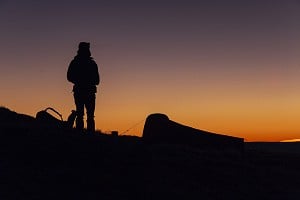
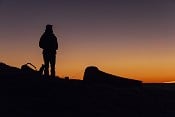
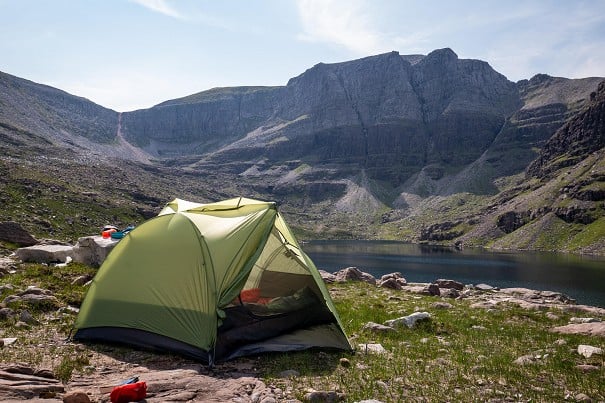

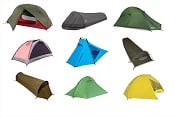


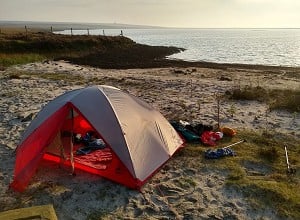
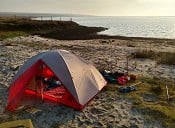
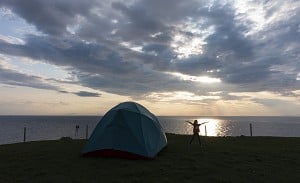
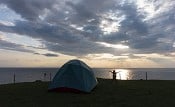
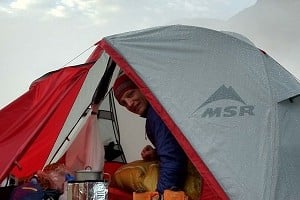
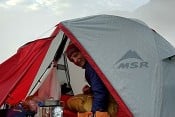
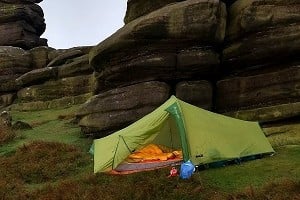
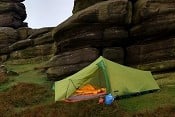
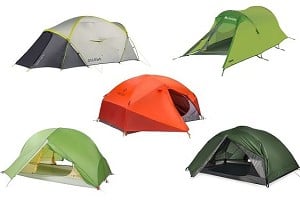

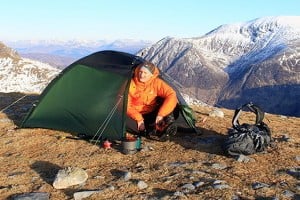
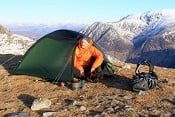
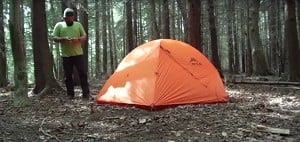

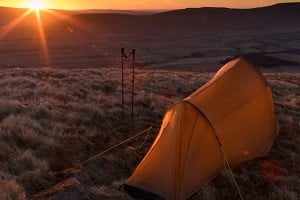
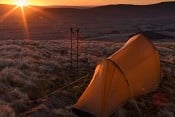
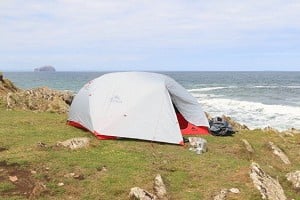
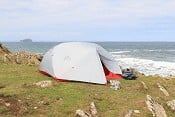
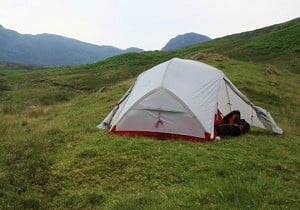
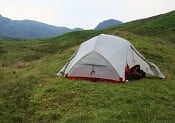
Comments
What is the difference between this and the MSR Hubba? It seems pretty much identical apart from the poles perhaps and less mesh?
Hubbas are lighter and cheaper, but not as sturdy in the weather. I would say the Hubba is a UK summer and bridge season model, but not really ideal for the wintry end of spring or autumn. The Access is almost opposite, really quite winter-worthy for a lightish backpackable tent but not so well suited to full summer.
Poles: It's decent but unremarkable alu (Hubba) vs snazzy Syclone (Access). The pole design is also different: With the Access the cross-pole reaches the ground to give you a lot more lateral stability, whereas in the Hubba it's just a short overhead section to increase space at head height.
Inner: Hubbas are very meshy, which is great in summer but I can attest to it being draughty and cold in less-than-nice weather. Very little mesh in the Access. Without pitching them side by side (I've got both here) I'd say the fly comes lower on the Access too, which would be better for keeping wind out but less venty if it's hot.
Sure there are other differences but I think they may be the main ones.
Looks really, really interesting. Does anybody know how many pegging points it has? I'm looking for something that I can peg out on snow with a max of 6 points (2 skis, 2 poles + 2 spare poles).
My Terra Nova/Wild County Voyager pegs out with three pegs, two on the porch, one at the rear. It gets used a lot when sea kayaking and pitching on a beach.
interesting - possibly a bit bigger and heavier than what I am looking for (a one person tent). I have an old Terra Nova Trisar -and this looks quite similar